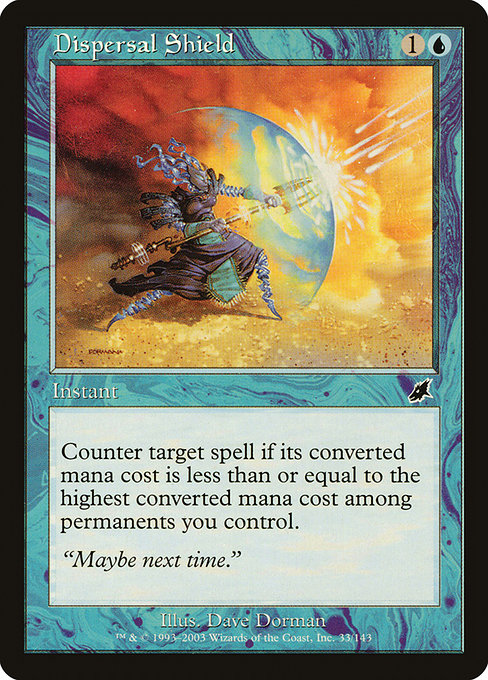
Image courtesy of Scryfall.com
Cross-format design constraints in MTG: a case study with Dispersal Shield
When a blue instant slides into a set and then into the wider battlefield of multiple formats, designers face a delicate balancing act. Dispersal Shield, a humble common from Scourge released in 2003, embodies a lean yet intriguing approach to cross-format viability. With a mana cost of {1}{U} and a characteristic edge that scales with your board, this card isn’t the loudest fireworks in the room, but it quietly rewards thoughtful play and board awareness 🧙♂️🔥. The shield’s text—“Counter target spell if its mana value is less than or equal to the greatest mana value among permanents you control”—is a tidy template that invites players to consider not just what they cast, but what you already have on the battlefield. In practice, that means your mana rocks and situational threats can tilt the scales decisively, even at instant speed 💎.
Cross-format design constraints ask: can a single card feel meaningful in Legacy and Commander, while also being comfortably approachable in Pauper and casual play? Dispersal Shield answers with a carefully tiered threat model. The threshold—your greatest mana value among permanents you control—acts as a moving target. Early games with few or modest permanents render the spell average in power, but as your board grows, the counter becomes more capable. This.dynamic mirrors the broad design philosophy of cross-format capable spells: they must be conditionally potent without being format-breaking. For a card that is common in rarity, that balance is especially important; you want players to identify multi-format value without feeling tethered to one meta or playgroup 🎲.
Flavor text on the card—“Maybe next time.”—hints at a mage who misreads the moment, a reminder that counterplay and timing are as much about psychology as raw power. In the broader sense, that sentiment threads through cross-format design: the most successful constraints come from predictable, repeatable patterns that players can learn and master, not from one-off gimmicks.
From a design perspective, Dispersal Shield leverages a blue control instinct while keeping complexity approachable. Its mana cost sits at a comfortable two—low enough to fit into early-game countermagic, yet high enough to discourage it from dominating every match. The effect is conditional, not unconditional; it asks you to gauge the “greatest mana value” now on the battlefield, not a potential future surge. That helps prevent the card from becoming an overbearing answer in formats where big-m mana threats are common, while still rewarding savvy players who manage their mana curve with care. In other words, it respects multi-format play by tying its strength to present reality rather than speculative possibilities 🔥⚔️.
Artwork and flavor, too, matter when crossing format boundaries. Dave Dorman’s illustration for Dispersal Shield captures a mage in a moment of poised calculation, a calm face behind ripples of магic energy. The art communicates blue’s identity—order, intellect, subtle deflection—while the flavor text keeps the mood anchored in modesty and timing. The set—Scourge—arrived in the era when WotC was balancing nostalgia with evolving design language, and Dispersal Shield embodies that transitional feel: a simple, functional spell that still carries a distinctive blue flavor and a tactile sense of a well-timed counterspell from a tabletop era long before hyper-optimized combos dominated the scene 🎨.
For players navigating cross-format constraints, Dispersal Shield offers a useful case study in deck-building discipline. In formats like Legacy, where mana values can spike with Tron-like or Big Blue strategies, your greatest mana value might climb quickly, enabling timely counters to midrange threats or early-game spells. In Pauper, the common rarity helps keep the card within reach for budget-conscious players, while in Commander, the threshold interacts with a wider range of permanents—lands, rocks, and colorless threats—that can push the counter into the realm where it actually matters most. The “greatest mana value among permanents you control” rule is a clever pivot away from brute-force negation toward situational control, a hallmark of good cross-format design 💎.
In practice, a player who owns a few mana accelerants or a consistent early engine can lean on Dispersal Shield to buy time or disrupt an opponent’s developing game plan. Its efficiency lies in timing and board awareness: you don’t always want to counter a cheap cantrip; you want to answer a crucial larger threat that would otherwise tip the scales. The card’s availability as both foil and non-foil in Scourge also reflects a design philosophy that accommodates collectors and players at different price points, reinforcing the sense that cross-format magic should feel accessible without diluting strategic depth 🔥🎲.
Beyond mechanics, the card’s broader presence across formats and its enduring appeal rest on the quiet satisfaction of “getting it right”—the moment when your choices line up with the board state and you glimpse the elegance of a well-placed counter. Dispersal Shield might not have the flash or fame of a marquee rare, but its design is a brass-tacked reminder: in MTG, format-hopping demand, and strategic nuance often rests in the margins—the right text at the right mana curve, the right moment to pull the trigger, the right moment to let a spell slip through and save your counter for something bigger later. And that, friends, is where magic really shines 🧙♂️💎.
Custom Neon Rectangular Mouse Pad 9.3x7.8 inMore from our network
- https://blog.rusty-articles.xyz/blog/post/blue-white-hot-star-in-sagittarius-cross-matched-spectroscopically/
- https://blog.digital-vault.xyz/blog/post/martyrs-cry-reprints-tracing-the-mtg-price-lifecycle/
- https://crypto-acolytes.xyz/blog/post/distant-hot-giant-illuminates-galactic-archaeology-via-dr3/
- https://blog.digital-vault.xyz/blog/post/tech-choices-for-dealing-with-traxos-scourge-of-kroogs-abilities/
- https://blog.digital-vault.xyz/blog/post/red-hue-of-a-hot-distant-giant-on-the-hr-diagram/